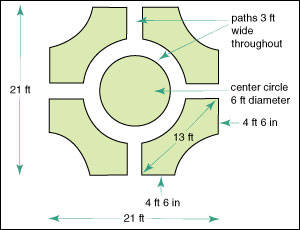A knot garden is artfully laid out and planned in order to resemble the threads of ancient Celtic knot work. Knot gardens have been a part of traditional garden design for hundreds of years, yet they are rarely seen these days. Here’s more about designing a knot garden and parterre.
Parterre diagram
The woven effect that defines a knot garden means daily maintenance. Because of the demanding upkeep, knot gardens have fallen from favor and have been replaced by less labor-intensive yet equally decorative plantings known as parterres. A parterre is basically a knot without a woven effect.
Our adaptation is based on a mid-17th-century design. We have chosen to construct the entire knot out of the reliably hardy boxwood, Buxus microphylla ‘Winter Gem’. (If ‘Winter Gem’ is not available, B. x ‘Green Gem’ or B. sinica var. insularis ‘Wintergreen’ would be equally good. Boxwood is equally happy in the sun or shade.
The Best Site
Parterres are at their best when viewed from above, so try and locate the planting where you will be able to look down on it. In choosing a site for your knot garden, look for a level spot not too far from the house, somewhere that will be visible year-round.
The evergreen outline of the knot garden we present here makes a perfect frame for massed plantings of annuals, perennials, and even herbs and vegetables, so if possible, choose a site that gets plenty of sun. If your property tends toward being shady, you can use the knot as a frame for shade-loving plants such as Hostas, astilbes, and impatiens. Finally, in looking for the ideal site, take into account the possibility that you may later want to extend your planting.
Getting Started
Our knot garden is a 21x21-foot square (see diagram). The central circle is six feet in diameter, the paths that separate the beds are three feet  wide, and the total linear footage of evergreen edging is 165 feet.
wide, and the total linear footage of evergreen edging is 165 feet.
You have a choice of exactly how many plants to buy. If you buy large specimens and plant them just touching one another, you will instantly achieve the illusion of an established planting, but large plants are much more expensive. By increasing the spacing between plants, you can cut down on the number of plants you will need. You can also cut down on cost by buying young, small specimens (sometimes called slips) and spacing them farther apart. If you do it this way, your miniature hedges will take a few years to knit together, but you will still achieve the “patterned” look right from the start.
To calculate the number of plants you will need, first divide the total linear footage of the knot outline (165 feet) by the average size of the plants you are buying. Then, by adjusting the distance between plants, you can come up with a final number for how many plants to buy.
Planting your knot garden in stages is also an option: laying out the central circle this year and adding the satellite beds next year. Alternatively, you can lay the whole knot garden out per our plan, and edge beds for this first season with a perennial such as ‘Silver Mound’ artemisia, or even with massed annuals such as alyssum.
Laying Out the Design
- Drive a wooden peg into the center of the 21-ft-square area
- Attach a three-ft long string to peg and mark out a circle six-ft in diameter with spray paint (the more visible, the better)
- To lay out the four satellite beds, cut a template from an inexpensive blue tarpaulin to the measurements given (see diagram). Lay the template on the ground and use pegs or spray paint to mark the outline.
- All paths that intersect within the knot should be three-ft wide. Have a three-ft piece of wood at hand to check for uniform width.
- Next, all grass needs to be removed from the central and satellite beds. Renting a sod-stripper for the day will make things quick and easy.
Planting
- The easiest way to plant hedges is by digging a planting trench, giving you the flexibility to shuffle plants around as needed.
- Water shrubs well before backfilling your trench.
- Plant the central bed first, following with the satellite beds one at a time. Remember the intersecting paths should be uniform at three-ft.
- You may want to add a focal point to the center of the central bed: a pruned tree, a birdbath—even a dense planting of oriental grass.
- Give the new hedges a gentle and conservative clipping to establish uniform height.
- Mulch around the base of the hedges, using dark, finely milled mulch.
- Finally, edge the grass around your new knot garden.
What Will It Cost?
The total expense depends on whether you go with young, small plants widely spaced or more-mature ones planted so they touch one another. Remember that you can also build the parterre in stages. Small 15-18 inch plants cost around $40 each; large 18- to 24-inch specimens are around $50 to $55 each. Most nurseries will give a “landscaper discount” of 25 percent to 30 percent for a quantity purchase. The total cost would be around $4,000 retail if you buy the biggest plants. If you buy smaller plants and space them conservatively, you could spend as little as $3,000 retail.
If you are buying large, field-dug boxwood plants, they will probably arrive balled and burlapped—and they’re heavy. Be prepared: Rent a handcart at your local rental center.
See our online Garden Planner to design your garden.
Comments